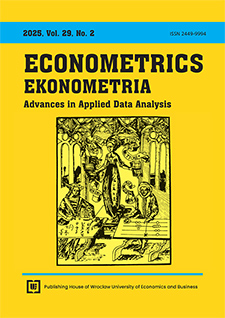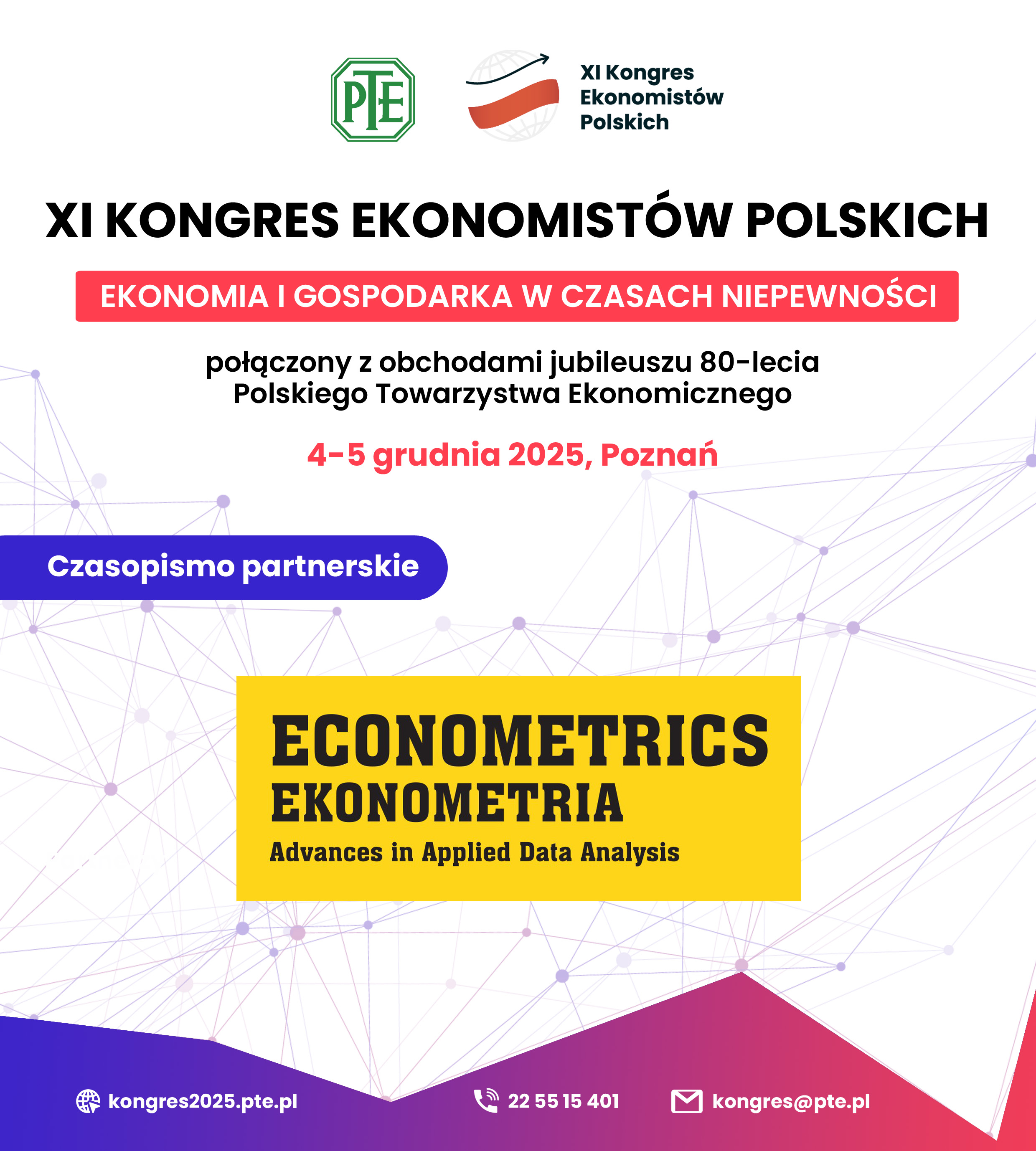Analysis of Financial Speculators’ Herd Behaviour Impact on the Instability of Commodity Prices. Evidence from Weekly WTI Crude Oil Market Data Using Uncertainty Theory (2018–2024)
DOI:
https://doi.org/10.15611/eada.2025.2.01Keywords:
herd behavior, WTI crude oil prices, uncertainty theory, ARDL modelling, financial speculatorsAbstract
Aim: The purpose of this paper is to model the herd behavior of financial speculators in order to demonstrate its effect on the instability of commodity prices, particularly WTI crude oil prices, following recent events: the COVID-19 pandemic, the war in Ukraine and the war in the Middle East.
Methodology: The authors approach relies on introducing uncertainty theory and VNM1 expected utility, rather than relying on ARDL modelling and dummy variables over the period 2018–2024, using weakly data provided by the CFTC.
Results: Our findings indicate the significant effect of variables, buying and selling positions of financial speculators and the war in Ukraine, namely increasing mimetic behavior of traders’ and financial speculators’ impact on prices. This result is valuable for a short-term relationship; however, there is no long-term relationship, which means no co-integration which can be interpreted by the efficiency of WTI crude oil market in long term.
Implications and recommendations: The prices of certain commodities have become unpredictable over the recent years, and the effect of fundamentals is becoming increasingly negligible in the face of speculators’ decisions on the financial markets. Hence the importance of taking stock of the impact of the mimetic behavior of financial speculators, and of regulating their activity.
Originality/value: In contrast to earlier research, introducing the behaviour or psychological impact of recent events on speculative behaviour on the financial markets and, in turn, on the physical markets makes this study unique. Therefore, rather than focusing on the direct impact of financial speculation on oil prices, this study aims to capture the indirect influence. The statistical tool used was ARDL modelling combined with the theory of uncertainty and VNM expected utility theory in order to capture this indirect effect, originally linked to the risk aversion of the various market players. This feature is very important because it allows to predict more precisely future market behavior and trends.
Downloads
References
Aulerich, N. M., Irwin, S. H., & Garcia, P. (2014). Bubbles, Food Prices, and Speculation: Evidence from the CFTC’s Daily Large Trader Data Files. NBER Chapters, 211–253.
Aulerich.N.M, Irwin.S, & Garcia.P. (2012). (35) Bubbles, Food Prices, and Speculation: Evidence from the CFTC’s Daily Large Trader Data Files | James V Carter – Academia.edu. https://www.academia.edu/35697050/Bubbles_Food_Prices_and_Speculation_Evidence_from_the_CFTC_s_Daily_Large_Trader_Data_Files
Bikhchandani, S., & Sharma, S. (2001). Herd Behavior in Financial Markets. IMF Staff Papers, 47(3). https://econpapers.repec.org/article/palimfstp/v_3a47_3ay_3a2001_3ai_3a3_3ap_3a1.htm
Brown, R. L., Durbin, J., & Evans, J. M. (1975). Techniques for Testing the Constancy of Regression Relationships over Time. Journal of the Royal Statistical Society. Series B (Methodological), 37(2), 149–192.
Buyuksahin, B., & Harris, J. (2011). Do Speculators Drive Crude Oil Futures Prices? The Energy Journal, 32(2), 167–202.
Büyükşahin, B., & Robe, M. A. (2014). Speculators, Commodities and Cross-Market Linkages. Journal of International Money and Finance, 42, 38–70. https://doi.org/10.1016/j.jimonfin.2013.08.004
Chatziantoniou, I., Filippidis, M., Filis, G., & Gabauer, D. (2021). A Closer Look into the Global Determinants of Oil Price Volatility. Energy Economics, 95, 105092. https://doi.org/10.1016/j.eneco.2020.105092
Chevallier, J. (2010). Spéculation et marchés dérivés du pétrole. Revue d’économie Financière, 98/99, 353-371.
Cifarelli, G., & Paladino, G. (2010). Oil Price Dynamics and Speculation: A Multivariate Financial Approach. Energy Economics, 32(2), 363–372. https://doi.org/10.1016/j.eneco.2009.08.014
Cordier, J., & Gohin, A. (2011). Quel impact des nouveaux spéculateurs sur les prix agricoles ? Une analyse empirique des fonds d’investissement. Post-Print, Article hal-01462701. https://ideas.repec.org//p/hal/journl/hal-01462701.html
Djamal, T. (2022). Russo-Ukrainian Crisis and Instability of the Cereal Market (Case of Wheat); “What impact on the Algerian economy? (Theoretical approach)”. Revue Finance & marchés, 9(2), 16–30. https://www.asjp.cerist.dz/index.php/en/article/200831
Djamal, T., & Said Chawki, Ch. (2018). Impact of Financial Speculation on Commodities Prices ’ Volatility through Commercials Risk Aversion “ Application for Wheat Prices”. Global Journal of Management and Business Research: B Economics and Commerce, 18(1), 39–51. https://globaljournals.org/GJMBR_Volume18/5-Impact-of-Financial-Speculation.pdf|
Eeckhoudt, L., Gollier, C., & Schlesinger, H. (2011). Economic and Financial Decisions Under Risk. Economic and Financial Decisions under Risk.
European Commission. (2011). European Commission Report on Financial Speculation in Agricultural Commodity Prices. https://www.senat.fr/rap/l10-623/l10-6231.pdf
Hamilton, J. (2009a). Causes and Consequences of the Oil Shock of 2007-08 (NBER Working Papers 15002). National Bureau of Economic Research. https://EconPapers.repec.org/RePEc:nbr:nberwo:15002
Hamilton, J. (2009b). Understanding Crude Oil Prices. The Energy Journal, 30(2), 179–206.
Hamilton, J. D., & Wu, J. C. (2015). Effects of Index-Fund Investing on Commodity Futures Prices. International Economic Review, 56(1), 187–205.
Hernandez, M., & Torrero, M. (2010). Examining the Dynamic Relationship Between Spot and Future Prices of Agricultural Commodities. IFPRI Discussion Papers 988. https://ideas.repec.org/p/fpr/ifprid/988.html
Irwin, S., & Sanders, D. R. (2012). Testing the Masters Hypothesis in Commodity Futures Markets. Energy Economics, 34(1), 256–269.
Irwin, S., Sanders, D. R., & Merrin, R. P. (2009). Devil or Angel? The Role of Speculation in the Recent Commodity Price Boom (and Bust). Journal of Agricultural and Applied Economics, 41(2), 53083.
Jovanovic, B. (2007). Bubbles in Prices of Exhaustible Resources (NBER Working Papers 13320). National Bureau of Economic Research. https://EconPapers.repec.org/RePEc:nbr:nberwo:13320
Juvenil, L., & Petrella, I. (2015). Speculation in the Oil Market. Journal of Applied Econometrics, 30(4), 621-649. https://onlinelibrary.wiley.com/doi/10.1002/jae.2388
Kilian, L. (2009). Not All Oil Price Shocks Are Alike: Disentangling Demand and Supply Shocks in the Crude Oil Market. American Economic Review, 99(3), 1053–1069. https://doi.org/10.1257/aer.99.3.1053
Kripfganz, S., & Schneider, D. C. (2023). ardl: Estimating Autoregressive Distributed Lag and Equilibrium Correction Models. The Stata Journal, 23(4), 983–1019. https://doi.org/10.1177/1536867X231212434
Krugman. (2009). The Increasing Returns Revolution in Trade and Geography – American Economic Association. https://www.aeaweb.org/articles?id=10.1257/aer.99.3.561
Lagi, M., Bar-Yam, Y., Bertrand, K. Z., & Bar-Yam, Y. (2011). The Food Crises: A Quantitative Model of Food Prices Including Speculators and Ethanol Conversion (SSRN Scholarly Paper 1932247). Social Science Research Network. https://doi.org/10.2139/ssrn.1932247
Levine, C., & Coburn, T. (2009). Excessive Speculation in the Wheat Market—Committee on Homeland Security & Governmental Affairs. https://www.hsgac.senate.gov/subcommittees/investigations/hearings/excessive-speculation-in-the-wheat-market/
Li, B. (2018). Speculation, Risk Aversion, and Risk Premiums in the Crude Oil Market. Journal of Banking & Finance, 95, 64–81. https://doi.org/10.1016/j.jbankfin.2018.06.002
Lu, Q., Sun, S., Duan, H., & Wang, S. (2021). Analysis and Forecasting of Crude Oil Price Based on the Variable Selection-LSTM Integrated Model. Energy Informatics, 4(2), 47. https://doi.org/10.1186/s42162-021-00166-4
Ludwig, M. (2019). Speculation and Its Impact on Liquidity in Commodity Markets. Resources Policy, 61, 532–547. https://doi.org/10.1016/j.resourpol.2018.05.005
Machina, M. J. (1987). Choice under Uncertainty: Problems Solved and Unsolved. The Journal of Economic Perspectives, 1(1), 121-154.
Masters, M. (2008). Financialisation in Oil Markets: Lessons for Policy | CEPR. https://cepr.org/voxeu/columns/financialisation-oil-markets-lessons-policy
Malkiel, B. G., E. F. Fama. (1970). Efficient Capital Markets: A Review of Theory and Empirical Work. The Journal of Finance, 25(2), 383–417. https://onlinelibrary.wiley.com/doi/10.1111/j.1540-6261.1970.tb00518.x
Masters, M. W., & White, A. K. (2008). The Accidental Hunt Brothers.
Pesaran, M. H., & Shin, Y. (1999). An Autoregressive Distributed-Lag Modelling Approach to Cointegration Analysis. In S. Strøm (Ed.), Econometrics and Economic Theory in the 20th Century: The Ragnar Frisch Centennial Symposium (pp. 371–413). Cambridge University Press. https://doi.org/10.1017/CCOL521633230.011
Pesaran, M. H., Shin, Y., & Smith, R. J. (2001). Bounds Testing Approaches to the Analysis of Level Relationships. Journal of Applied Econometrics, 16(3), 289–326.
Rolli, V. (2012). Commodity Price Co-Movements: What Do They Tell Us?. FAO.
Sornette, D., Woodard, R., & Zhou, W.-X. (2009). The 2006-2008 Oil Bubble and Beyond. Physica A: Statistical Mechanics and Its Applications, 388(8), 1571–1576. https://doi.org/10.1016/j.physa.2009.01.011
Stiglitz, J. E. (1975). Incentives, Risk , and Information: Notes Towards a Theory of Hierarchy. The Bell Journal of Economics, 6(2), 552–579. https://doi.org/10.2307/3003243
UNCTAD. (2011). Price Formation in Finacialized Commodity Markets. The Role of Information. United Nations. https://unctad.org/system/files/official-document/gds20111_en.pdf
US Governmental affairs, H. security. (2007). Levin-Coleman Report Finds Speculation Adding to Oil Prices: Put The Cop Back On The Beat – Committee on Homeland Security & Governmental Affairs.
Venegas, M. del R., Feregrino, J., Lay, N., & Espinosa-Cristia, J. F. (2024). Food Financialization: Impact of Derivatives and Index Funds on Agri-Food Market Volatility. International Journal of Financial Studies, 12(4). https://doi.org/10.3390/ijfs12040121
von Neumann, J., Morgenstern, O., & Rubinstein, A. (1944). Theory of Games and Economic Behavior (60th Anniversary Commemorative Edition). Princeton University Press. https://www.jstor.org/stable/j.ctt1r2gkx
Zhang, Y.-J., Chevallier, J., & Guesmi, K. (2017). “De-financialization” of Commodities? Evidence from Stock, Crude Oil and Natural Gas Markets. Energy Economics, 68, 228–239. https://doi.org/10.1016/j.eneco.2017.09.024
Downloads
Published
Issue
Section
Categories
License
Copyright (c) 2025 Tebache Djamal, Chetbani Saida

This work is licensed under a Creative Commons Attribution-ShareAlike 4.0 International License.
Accepted 2025-05-08
Published 2025-06-12









